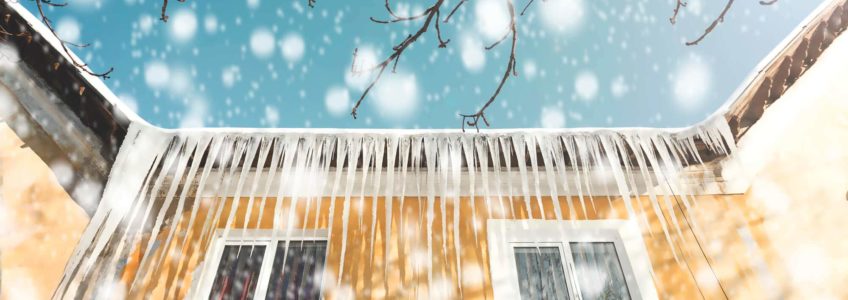
Inspecting your roof is an essential part of every homeowner’s annual maintenance checklist. When winter ushers in some of the harshest weather conditions, it can severely impact a roof’s integrity. Ice dams are a common occurrence during the colder months and can wreak havoc on your roof. It’s crucial to utilize the right ice dam removal techniques to avoid further damage to your home’s topmost layer of protection.
What Are Ice Dams?
Have you ever noticed ridges of ice and snow accumulating at the edge of your roof, often accompanied by extensive networks of icicles? If the answer is yes, you’ve probably experienced ice dams on your property.
Ice dams form in the winter and are incredibly detrimental to the integrity of your home’s roof. They occur when water becomes backed up behind the accumulating ridges of snow, allowing water to pool on the edge of your roof and potentially seep into the interior of your home. Too much ice dam build-up will typically require professional removal.
What Causes Ice Dams?
You might think that there is an easily explained answer to what causes ice dams: ice and other cold weather conditions. Although cold weather conditions are an obvious culprit, other factors contribute to the formation of ice dams as well, including:
- Uneven heating of your home’s interior
- Fluctuating outdoor temperatures
- Snow and ice accumulation
- Wind exposure
- Sun exposure
- Air leakage in your attic
The formation of ice dams often indicates uneven surface temperatures on your roof. Outside temperatures, extreme weather conditions, snow accumulation, and your home’s interior temperatures all interact to cause ice dams on your roof’s edge. It’s not only residential homes impacted by this issue; ice dams can affect commercial businesses as well.
So, how exactly do these factors work together to form ice dams on your home or commercial building? Well, the warmer temperatures at the top of the roof will cause snow and ice to melt. If the bottom half of the roof is below the freezing point, the melting run-off re-freezes and forms an ice dam on the edge of the roof. The higher peaks of your roof are heated either from your home’s interior or from sitting in the sun for prolonged periods.
Although there are some simple, short-term solutions to remove ice dams yourself, there is potential for them to damage roofing materials. Push brooms or “roof rakes” are tools used to help remove snow, but they sometimes remove shingles too.
To avoid exacerbating the existing issue, most roofing contractors will recommend new attic insulation and natural roof ventilation to combat the creation of ice dams in the long-term. With adequate insulation and a high-performing ventilation system in your home’s attic, it’s less likely that the roof heats unevenly and ice dams will occur less frequently, if at all.
How Ice Dams Can Harm Your Home
It’s crucial to take care of ice dams right away when you notice them forming on your roof. If left unattended, ice dams can cause considerable damage to your roof and the interior of your home or business. The damage often inflicted by ice dams includes:
- Water damage
- Stains
- Mold and mildew
- Pooling water
- Wood rot
- Collapsed roof structure (in extreme cases)
Act quickly as ice dams accumulate to avoid costly expenses due to damage to your roof or your home’s interior. With one phone call to a local roofing company, your ice dam problem will evaporate in no time.
Removing Ice Dams From Your Roof
The primary method for removing ice dams is with low-pressure steam. Although it might seem easy to do it yourself, getting rid of ice dams can be a hazardous task for even the handiest of homeowners. Walking on an icy roof without the proper safety equipment is an excellent way to ask for an accident. It’s wise to work with a professional to take care of your ice dam problem promptly.
Ice Dam Steaming
Ice dam steaming is a tried and true technique for removing ice dams from roofs. The process converts cold water into low-pressure steam, which is then sprayed through a specially designed nozzle, melting the ice on the roof entirely. Then, the melted ice and snow can flow through the freshly cleared gutters away from your home.
For the best results, ice dam steamers typically operate at an optimal temperature of 290 degrees Fahrenheit. At the right temperature, ice removal is incredibly easy, resulting in less water run-off and a quick clean up process. Overall, ice dam steaming is the safest and most effective way to remove ice dams from your roof.
Low-Pressure Steam vs. Hot Pressure Washers: The Preferred Method for Ice Dam Removal
So why do the majority of roofing professionals prefer to use low-pressure steam systems to remove ice dams over a hot pressure washer? Low-pressure steam has a soft, gentle touch, making it the safest solution to use on your roof.
Hot pressure washers are perfect for removing snow and ice from surfaces like pathways or parking lots. However, they are too powerful to point directly at roofing materials and can cause severe damage to shingles. Thus, low-pressure steamers are the best solution for destroying ice dams at the source.
Professional Ice Dam Removal Is the Right Choice
Attempting to walk on an icy roof and remove ice dams yourself is never a good idea. Instead, assess the ice accumulation and any potential damages with the help of a professional. You can consult with a construction company specializing in ice dam removal so you stay safe on the ground while still ensuring your roof’s stability.
Whether you are a commercial business owner or a residential property owner, the presence of ice dams can be a cause for concern. Don’t risk wrecking your roof with at-home solutions like rakes or rigged up heating systems. Your preferred roofing contractor can easily assess the impact ice dams are having on your home and supply straightforward solutions in a snap.
When you notice ice dams forming this winter, contact a roofing company like Advantage Construction to administer ice dam steaming around your home or business. When the process is completed correctly, you’ll feel at ease knowing that both the interior and exterior of your home or business will be protected from potential damage all winter long.
